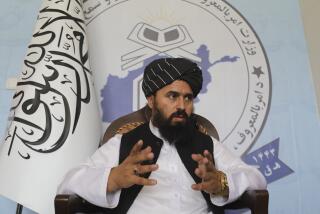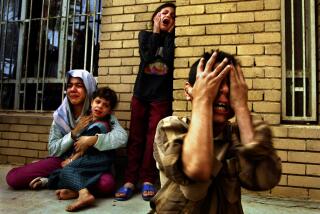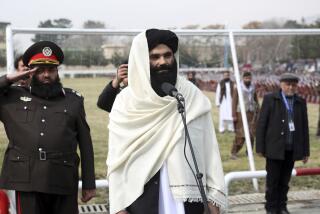Slain Afghan Warrior Is Reborn as National Icon
- Share via
KABUL, Afghanistan — His pensive, bearded visage adorns virtually every wall and windshield in this capital, where the wars he waged against Soviet and Taliban oppressors seem finally to have ended in victory for his people as well as a martyr’s death for himself.
Ahmed Shah Masoud, the ethnic Tajik warrior who kept Afghan hopes for freedom from foreign domination alive through bloody battles for two decades, has been reborn as a national icon in the six weeks since his Northern Alliance cohorts took power in Kabul.
Not since Lenin or Mao does a departed revolutionary seem to have risen so quickly to a position of state-sponsored reverence as the “Lion of the Panjshir” has since his Sept. 9 killing.
Carried out by suicide bombers posing as journalists, Masoud’s slaying two days before the terrorist strikes against the U.S. is seen as part of the heinous strategy of Osama bin Laden. The Saudi-born exile and his Al Qaeda terrorist network apparently calculated--erroneously, it seems--that Masoud’s death would demoralize his Northern Alliance fighters and frustrate any Western attempts to use the anti-Taliban forces to punish Bin Laden and his protectors.
But the alliance’s swift sweep from its remote northern stronghold near Mazar-i-Sharif in the wake of punishing U.S. airstrikes against the Taliban brought Masoud’s warriors into the capital in a blaze of gunfire and glory. And since their Nov. 13 arrival, Kabul has become all but a shrine to the fighter who attained legendary status in his 48-year lifetime.
At the entrance to the Foreign Ministry compound, Masoud’s rifle hangs beneath a poster-size portrait of him in memory of his service to the newly pacified country.
The white marble exterior of the Interior Ministry, where Afghanistan’s interim government was sworn in Saturday, sports a story-high mural of Masoud and an even larger painting hung as the backdrop for an inauguration ceremony attended by 2,000 Afghan tribal leaders. A chair bearing floral tributes and a portrait of the late fighter stood next to outgoing President Burhanuddin Rabbani in symbolic inclusion of his memory in the momentous transfer of power.
“He is a man who sacrificed his blood for the sake of Afghanistan. We remember him with reverence,” said new Prime Minister Hamid Karzai, when asked whether the cult of worship emerging around the Tajik Masoud, whose ethnic group is a minority in the country, risks alienating Pushtuns, the largest ethnic group.
A Pushtun himself, Karzai also paid tribute to Masoud in his inaugural address, praising “my great brother and martyr” and evoking tearful shouts from the assembled masses celebrating the warrior’s union with Allah.
Although the reverence for Masoud is clearly sponsored by the new regime here, his legacy is neither universally lauded nor untainted by the chaos and bloodshed that have made a tradition of tragedy in Afghanistan.
Although he was the military genius who harassed Soviet troops throughout their 1979-89 occupation--and never relented in his quest to drive the fanatic Taliban from Afghan soil--his short term in government as defense minister in the early 1990s is remembered most for anarchy and conflict that left 50,000 Kabul civilians dead.
Still, within days of the arrival of victorious Northern Alliance fighters in mid-November, pictures of Masoud began appearing on the walls of government office buildings in places previously reserved for the former king or the dizzying succession of heads of state.
On the first day of Eid al-Fitr, the Muslim festival celebrating the end of the Ramadan month of fasting, vans and pickups belonging to the government, then in the hands of alliance forces, fanned out across the capital to hand out posters of Masoud. The capital’s always frenzied traffic ground to a standstill, and drivers were mobbed by bicyclists and street people desperate to get their own tokens of remembrance.
The only alliance figure to have overshadowed Rabbani, Masoud provides a rallying point for residents of a city ruled by an interim Cabinet dominated by Northern Alliance figures.
But as Karzai attempts to guide war-weary Afghans into an age of civil society and peace, the legend of the warlord may lose its luster.
“Most people in Afghanistan respect him, but the first symbol of our country should be one of unity, not of fighting,” said Wali Mohammed Nasei, a professor of law and politics at Kabul University. “He is now the greatest historical figure of the past century, as he fought for human rights and the rights of women, but with time he will likely occupy a less prominent role.”
For the time being, Masoud remains the repository of respect and glory in a nation bereft of heroes.
More to Read
Sign up for Essential California
The most important California stories and recommendations in your inbox every morning.
You may occasionally receive promotional content from the Los Angeles Times.














